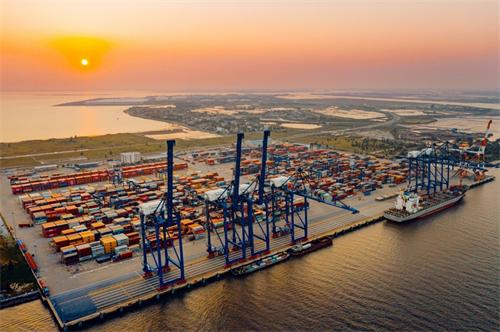ASEAN’s Supply Chain Win: Vietnam Surpasses China in US Imports

Since the outbreak of the US-China trade war in 2018, global supply chains have undergone dramatic restructuring. While the United States wielded tariffs in an attempt to weaken China’s manufacturing dominance, it inadvertently fueled the rise of other countries. Vietnam, along with Mexico and India, emerged as dark horses in this global economic reshuffle—among them, Vietnam stands out prominently.
Vietnam's Soaring Exports to the US: Who’s the Biggest Winner?
In April 2025, Vietnam’s exports to the United States surpassed $12 billion for the first time, marking a 34% year-on-year increase and reaching a new post-pandemic high. In the first four months of 2025 alone, Vietnam's trade surplus with the US hit $38 billion, up 25% from the previous year. In 2024, Vietnam exported goods worth $136.6 billion to the United States, representing nearly one-third of its total exports. This underscores how heavily Vietnam’s economy relies on the American market as a key trading partner.
This is no coincidence. Global brands like Nike and Adidas have already shifted over 50% of their footwear production to Vietnam. Giants such as Samsung and Apple have also restructured their supply chains, relocating significant assembly operations to the country. According to Viner’s “Customs Union Theory,” under mutual 25% tariffs between the US and China, if a third country like Vietnam gains just 1% of the US market share, it could result in $18 billion in trade diversion. This theory precisely explains Vietnam’s recent export boom.
What’s Driving Vietnam’s Rise? A Confluence of Policy, Cost, and Geopolitics
Vietnam’s rapid ascent is not solely due to trade diversion—it’s the result of multiple converging factors. First, US geopolitical strategy encourages companies to shift supply chains from China to “friendly” countries, making Southeast Asia a top choice. According to UNCTAD, Southeast Asia attracted $267 billion in manufacturing foreign direct investment (FDI) in 2024, up 35% year-on-year, with 65% originally destined for China.
Second, Vietnam’s export-driven economy is highly open. Its manufacturing sectors—including electronics, textiles, agriculture, and machinery—supply goods globally, creating a virtuous economic cycle. Agreements like the CPTPP have also institutionally supported Vietnam’s export-oriented model.
Moreover, Vietnam enjoys a significant labor cost advantage. A Vietnamese worker earns only about 40% of the monthly wage of a worker in China’s Pearl River Delta. Combined with Western tariff exemptions on non-Chinese goods, this creates ample arbitrage opportunities. For example, Samsung and Apple have shifted over 30% of their China-based capacity to Vietnam, helping maintain Vietnam’s GDP growth at an average of 6.5% annually.
Can Vietnam Replace China as the World’s Factory?
Despite Vietnam’s momentum, it faces several short-term challenges in fully replacing China’s role in global manufacturing. Vietnam’s national electricity company reported that in 2024, power shortages caused a 65% year-on-year increase in production disruptions across industrial zones. Other limiting factors include infrastructure bottlenecks, a shortage of skilled workers, and a lack of industrial ecosystem depth, all of which hinder the country’s ability to move up the manufacturing value chain.
By contrast, China’s manufacturing advantage remains solid. Its complete industrial ecosystem, developed logistics infrastructure, and massive pool of skilled labor form a formidable foundation that’s hard to replicate in the short term. Data shows that China has been Vietnam’s largest import source for 15 consecutive years. Vietnam’s manufacturing still heavily depends on Chinese components and raw materials, indicating that the two countries’ supply chains are more complementary than competitive.
China’s Manufacturing “Upgrade”: Moving Toward High Value-Added Production
In reality, China is quietly shifting gears. According to McKinsey’s 2024 report Reshaping Global Value Chains, while some labor-intensive sectors are moving offshore, China is consolidating its position in mid-to-high-end manufacturing. China remains the world’s largest consumer of industrial robots, accounting for 38% of global demand. In emerging strategic industries such as electric vehicles, solar energy, and lithium batteries, Chinese companies hold over 40% of global market share. These trends highlight China’s transition toward “smart manufacturing” and “green production.”
The Cost of Overheating: Vietnam Faces Trump-Style Blowback
Yet Vietnam’s export boom has triggered external risks. In April 2024, the Trump administration unexpectedly imposed punitive tariffs of up to 46% on Vietnamese goods—an even higher rate than the 34% imposed on Chinese products. Why would a small country with a GDP only 2.3% the size of China’s (at just $429.7 billion) become a top target?
The answer lies in the data. Between 2019 and 2024, Vietnam’s trade surplus with the United States experienced a sharp increase, rising from $55.8 billion to $123.5 billion. By 2024, this surplus accounted for nearly 30% of Vietnam’s gross domestic product, highlighting its growing economic dependence on US demand. US critics accused Vietnam of becoming “another China”—merely relabeling goods without changing their origin. According to the US Bureau of Economic Analysis, between 2018 and 2023, American firms shifted around $58 billion worth of production capacity from China to Vietnam, resulting in the loss of 230,000 US manufacturing jobs.
What particularly alarmed US officials was the surge in “rebranded exports.” Vietnamese customs data shows that 38% of Vietnam’s exports to the US were actually Chinese-origin goods re-exported under Vietnamese labels, especially in sectors like electronics and furniture. The US Commerce Department has bluntly stated that Vietnam is becoming a transshipment hub for evading tariffs on Chinese goods.
Conclusion
Vietnam’s rapid rise amid the US-China trade war clearly marks it as one of the biggest winners in the global supply chain realignment. However, behind the glowing export data lies a growing risk of backlash. Without genuine industrial upgrading and diversification, Vietnam could fall into the trap of low-end manufacturing dependency—vulnerable to both global demand fluctuations and geopolitical retaliation.



